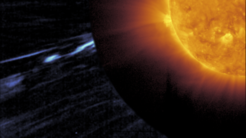Magnetic Switchback in the Solar Corona
ESA’s Solar Orbiter has observed a solar switchback in the Sun's corona. A new study now provides clues to its origin.
During Solar Orbiter's yet closest flyby of the Sun earlier this year, the coronagraph Metis witnessed a curious spectacle in the solar corona: an S-shaped plasma structure several hundred thousand kilometers across, moving away from the Sun at high speed. A group of researchers including scientists from the Max Planck Institute for Solar System Research (MPS) in Germany believe this structure to be a solar switchback. The phenomenon has been known for decades from solar wind measurements, where it shows up as a brief reversal of the magnetic field. The data from ESA’s Solar Orbiter together with new computer simulations now make it possible to trace the origin of the phenomenon down to the lower corona. As the team reports today in the journal "The Astrophysical Journal Letters", the switchbacks are triggered in the lower corona by restructurings in the solar magnetic field.

The Sun’s magnetic field is noticeable not only in the star’s immediate vicinity. Instead, the solar wind, the continuous stream of charged particles from the Sun, carries it far out into space, thus creating the heliosphere. In the course of this process, sudden and locally occurring reversals of the magnetic field are apparently not uncommon. In close proximity to the Sun, the phenomenon has in recent years been frequently encountered by NASA's Parker Solar Probe. At significantly larger distances from the Sun, the German-American twin probes Helios I and II as well as NASA's Ulysses spacecraft sporadically captured similar data in the 1970s and 1990s. The so-called switchbacks last a few hours at most, have an S-shaped form and are often accompanied by accelerations of the solar wind. However, until now their origin has remained largely unclear.
The new observations by Solar Orbiter, released today, provide new insights - in part because the data from ESA’s spacecraft differ fundamentally from those of their predecessors. Previous encounters with switchbacks were in situ-measurements: the spacecraft flew through the solar wind and recorded the strength and direction of the magnetic field at their own position. Solar Orbiter, on the other hand, is also equipped with telescopes and cameras, allowing it to image the phenomenon in its entirety.
Curved plasma structure
Solar Orbiter’s coronagraph Metis accomplished this feat on March 25 of this year, one day before the spacecraft reached its closest point to the Sun to date. Less than 48 million kilometers separated Solar Orbiter from the Sun at that point. The coronagraph occults the bright solar disk as well as the Sun's inner atmosphere, making processes in the much fainter outer atmosphere visible. The instrument's cameras were developed and built at the MPS.
In the images now published, an elongated, S-shaped plasma structure can be seen, initially appearing at a height of 2.6 solar radii above the solar surface. It moves radially away from the Sun at a speed of at least 290,000 kilometers per hour, while a smaller portion of the structure appears to be propagating in the opposite direction.
"The great strength of Solar Orbiter is that the spacecraft is equipped with instruments that can look into different layers of the Sun at the same time," explains MPS scientist Dr. Luca Teriaca, Metis Co-Principal Investigator and co-author of the current study. "This allowed us for the first time to trace the switchback back to its origin," he adds. Solar Orbiter's Extreme Ultraviolet Imager (EUI) was also observing on March 25. The instrument, to which the MPS contributed one of three telescopes, captures extremely short-wavelength ultraviolet radiation from the lower corona. Its field of view is thus much closer to the Sun’s surface than that of Metis.
Below the switchback, the EUI images from Marc 25 show a flurry of bright plasma loops extending from the solar surface into the lower corona. Such coronal loops often occur in connection with active regions, areas of strong magnetic field strength at the solar surface. There, hot plasma flows along the curved, closed field lines of the solar magnetic field.

Reconstruction of the magnetic field
To understand how the EUI and Metis observations fit together, the team performed extensive magnetohydrodynamic calculations. The computer simulations allowed the researchers to model the architecture of the solar magnetic field at the time of the switchback and to trace the evolution and propagation of the curious structure itself.
"The calculations suggest that switchbacks form when the magnetic field above an active region reconfigurates," says MPS scientist and co-author Dr. Regina Aznar Cuadrado. In close proximity to the closed magnetic field lines above the active region, the team found open field lines extending far into space. Where the two types of field lines interact, the magnetic field restructures and energy is released in the form of an S-shaped plasma perturbation.
"Switchbacks are often accompanied by a local increase in solar wind speed," says MPS scientist and co-author Prof. Dr. Hardi Peter. "The current study may therefore help to understand how the solar wind is accelerated into space," he adds.
From the corona to the heliosphere
The team now hopes Solar Orbiter will witness more switchbacks in the coming months. Ideally, the plasma structure will then propagate toward the spacecraft and eventually reach it. In this way, not only Solar Orbiter's telescopes but also its in situ instruments could perform measurements - and the spacecraft could for the first time track the phenomenon from its point of origin to the heliosphere.













